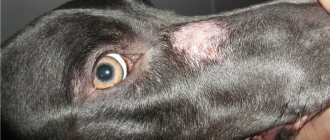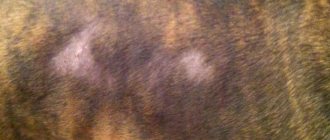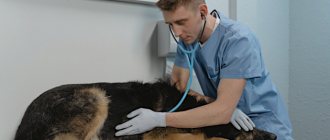The dog's fur turns red. This problem is faced not only by owners of snow-white four-legged animals, but also by red and even black pets. It’s just that on white barbs this becomes noticeable almost immediately, and the owners quickly begin to sound the alarm.
Several years ago we had to face such a problem. During the winter season, Jack's fur on his thigh began to turn red intensely. Moreover, the skin was absolutely clean. Only the hairline changed color.
So what causes red fur in dogs? What is the reason for this phenomenon? Let's figure this out together.
Why is wool dyed?
The red coloring of wool occurs due to porphyrin. This substance is formed as a result of the metabolism of hemoglobin and is mainly excreted in the feces, but small amounts are also found in tear fluid and saliva. Therefore, red spots on the fur indicate that it has been wet for quite a long time due to tears or saliva and this may be a sign of disease.
There is another reason for hair coloring - the yeast-like fungus Malassezia. It colors the fur a rusty brown shade. This fungus joins an existing problem, meaning it is rarely an independent cause.
It makes no sense to understand shades of red. In any case, such coat coloring requires consultation with a veterinarian. And depending on where the wool is dyed, you need to contact different specialists.
Treatment options
There is no general scheme for treating pododermatitis in dogs. In each case, an individual approach is important.
Treatment tactics depend on the diagnostic results. The goal is to combat the causative agent of the underlying disease.
Based on the examination results, the following treatment may be prescribed:
- treatment of affected areas with antiseptic agents;
- antibacterial therapy;
- surgical intervention;
- antifungal therapy;
- antihistamines;
- dietary nutrition;
- lifelong maintenance therapy.
The choice of treatment method depends on what type of pododermatitis (type of inflammation) you are experiencing.
Aseptic pododermatitis
It manifests itself as a persistent inflammatory process and pain syndrome. There is no purulent tissue damage. The main treatment is thorough treatment with antiseptic drugs. It is carried out by the owner himself.
Purulent pododermatitis
A disease complicated by purulent tissue infection. This species has pronounced symptoms: the dog groans in pain and the body temperature rises. Antimicrobial therapy is indicated for the treatment of purulent pododermatitis. And in severe cases, surgery may be required. The doctor opens the abscesses and rinses the cavities with an antiseptic and antibiotics.
Hair coloring under the eyes
Tearing is normal if it is short-term. Tears protect the eyes and are also needed to wash away foreign objects (specks, hairs). Each of us periodically has watery eyes if something gets into them.
When lacrimation does not go away for several days or longer, this may indicate pathology. The most common are entropion of the eyelids, obstruction of the nasolacrimal duct, foreign body, corneal ulcer, keratoconjunctivitis sicca, or systemic diseases accompanied by ocular symptoms. In any case, the pet must be shown to a veterinarian specializing in ophthalmology.
What should the ophthalmologist do?
Of course, carefully examine the eyes and eyelids in bright light. If there are special devices (slit lamp, ophthalmoscope), the veterinarian will be able to assess the condition of the cornea, anterior chamber of the eye, lens, and fundus.
Carry out mandatory ophthalmological tests (Schirmer test, fluorescein staining of the cornea, assessment of the patency of the nasolacrimal duct), additional studies if necessary.
Conduct a full examination of the animal.
Assume and voice the diagnosis, prescribe treatment.
How pain causes red paws
A dog that has pain in one of its legs will chew and lick it in an attempt to relieve the discomfort. This may cause their paws to turn red. Most often you will only see one red paw if it is associated with pain. If you think your dog may be in pain, check his paw and find the source. Be sure to check the padding and between your dog's toes for any foreign objects or debris. Dogs can easily pick up things like thorns, burrs, rocks, glass shards or pieces of metal while outdoors, all of which can cause painful injuries.
© shutterstock
If you find anything foreign during your inspection, remove the offending object with tweezers, and then wash and disinfect your dog's paw to keep it free of dirt and germs. Be sure to keep a close eye on your dog. If you notice that the area where your dog's paw was injured looks like it is starting to swell, or it feels hot to the touch, or if it starts oozing any pus, contact your veterinarian immediately because these could be signs of a bacterial infection . Additionally, if your dog has torn a paw pad or has a deep cut that won't close on its own, your dog may need stitches.
Coloring the fur around the mouth
Constant wetting of the hair around the mouth with saliva occurs in some breeds of dogs (spaniels, bulldogs, mastiffs) due to lip folds and infection, but more often it is a sign of some kind of trouble in the oral cavity - inflammation of the gums or dental pathology. And all this is the diocese of the dentist.
What should the dentist do?
Carry out a thorough examination of the oral cavity using dental instruments (as in humans). It is rare that a pet will allow a good dental examination, so sedation is usually required at this stage.
Dental X-ray. Without it, it is impossible to understand the condition of the roots of the teeth and bone tissue. Always performed under sedation.
Assume and voice the diagnosis, carry out treatment.
What to do at home
The appearance of spots on the skin, changes in coat color in dogs - all these insidious abnormalities cannot be treated on your own.
Without specific diagnostics in a veterinary clinic and finding out the main cause of the changes that appear, it is impossible to alleviate the animal’s condition.
Therefore, at home you should follow all doctor’s prescriptions, and if the diagnosis of lupus is confirmed, you should protect your dog from exposure to ultraviolet rays.
The use of ointments and medications selected by a doctor will speed up your pet’s recovery.
Diagnostics
Since a dog's paws can become red and inflamed for a variety of reasons, a visit to the vet may be your best option if you have any concerns or doubts about what you're dealing with. Once you take your dog to the vet, he or she will be able to use a variety of tests and methods to find out why your dog's paws look red.
© shutterstock
Typically, the veterinarian will begin with a physical examination, paying particular attention to the paws, since this is the area you are complaining about. This way they can see what's going on. If your dog has experienced hair loss associated with irritation, your veterinarian may use a microscope to examine the area and the hair follicle. Sometimes there may be a structural weakness in the hair itself.
The veterinarian may also take a skin sample from the affected paw to help them get a visual image under a microscope and determine if your dog has any parasitic, fungal, or bacterial infections on the surface of the skin. Of course, your veterinarian will also run standard tests such as a urinalysis, complete blood count, and full chemistry profile. These tests will help your veterinarian evaluate your dog's hormonal balance and check for any infections or signs that your dog's immune system has gone haywire in some way.
Parasitic skin diseases in dogs with photographs
The causative agents of this group of diseases are ectoparasites. They affect the surface of the animal’s body or penetrate directly under the skin, remaining in its upper layers. Their vital activity causes severe scabies. In an attempt to relieve the itching, the infected dog often scratches until it bleeds, complicating the parasitic infestation with a secondary infection.
Fleas
Little bloodsuckers often change their owners and do not disdain human blood at all. They easily jump onto a new host within 33 cm and multiply quickly. Without timely adoption of countermeasures, the entire household becomes infected.
Fleas are easy to spot due to their activity. If you find suspicious movement of black or brown grains on your pet’s body, do not delay treatment. These parasites often carry deadly infections, so their bites can cause quite serious problems.
Scabies mites
These microscopic mites reach a length of no more than 0.45 mm. Unlike fleas, they cannot be seen with the naked eye. Despite this, such an infection has several specific signs:
- redness and cracking of the skin, as well as the appearance of ulcers and blisters with reddish-clay contents – demodex canis mite;
- the formation of thin light gray lines with a bubble in different parts of the body – sarcoptes scabiei mite;
- numerous scales, dry crusts and small rash – cheyletiella yasguri mite;
- partial baldness, wrinkling and thickening of the skin - notoedres cati mite.
These ticks are not dangerous to humans. The very first (demodex canis) are found only in animals and are present in their bodies from birth. All the rest are simply not able to gnaw through the human epidermis, so they do not stay there for too long.
The prognosis for four-legged friends is less favorable. Tick infestations complicated by a bacterial infection reduce the chances of recovery by up to 50%.
lice eaters
The main food of lice eaters is wool and keratinized particles of the epidermis. Blood appears on their menu only thanks to numerous scratches. They are not transmitted to humans, so there is no need to be afraid of an infected pet.
Parasites resemble ordinary white dandruff. Their activity greatly weakens the immune system, so prolonged infection is often complicated by helminthiasis, allergies, infections and exacerbation of chronic pathologies.
How Contact Dermatitis Causes Red Paws
Contact dermatitis occurs when your dog's paws come into contact with something they are sensitive to and it irritates their skin. It could be literally anything in your dog's environment, from carpet and floor cleaners, certain fabrics and fibers, to salts found on icy roads, to irritants on your lawn (or your neighbor's lawn) that they react to.
These types of irritations are difficult to prevent because it can be difficult to narrow down what is causing the disorder. You can talk to your veterinarian about treatment options, and use natural products around the house and lawn to keep your dog's paws clean and free of irritants.
© shutterstock
Causes of skin problems
Based on the cause, treatment is selected for the animal, so it is very important to promptly identify and eliminate all provoking factors. Most often, skin problems arise due to:
- hereditary diseases (genetic predisposition and congenital anomalies);
- poor living conditions (lack of hygiene, lack of fresh air, hypothermia);
- poor quality nutrition (poor diet, feeding cheap or expired dry granules).
The risk group includes breeds with increased sensitivity: Labradors, Dalmatians, Shar-Peis, German shepherds, cocker spaniels, golden retrievers, poodles, chow-chows, pugs. When caring for such pets, you should be especially careful, as even tight-fitting overalls can cause extensive baldness.
Wounds and bites on dogs' legs
Finally, bites and wounds are very irritating to the skin of your dog's feet. They will chew and scratch, which will worsen the injury and may become infected. From an infected insect bite, a broken nail to a small wound, even infection due to, for example, a plant, a thorn or a foreign body stuck in the skin.
Again, the veterinarian will be the one who knows best what to do in your case and can give you the best treatment other than basic medications.











